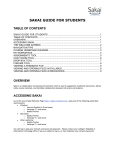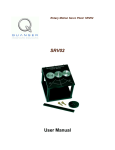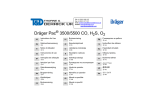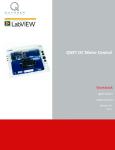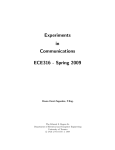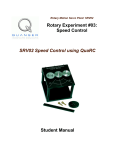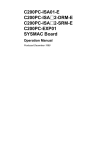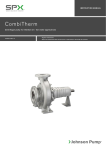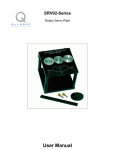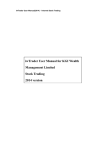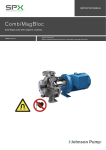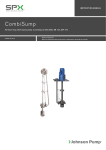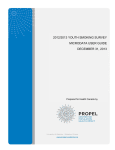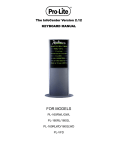Download Rotary Experiment #01: Modeling SRV02 Modeling using QuaRC
Transcript
Rotary Motion Servo Plant: SRV02 Rotary Experiment #01: Modeling SRV02 Modeling using QuaRC Student Manual SRV02 Modeling Laboratory – Student Manual Table of Contents 1. INTRODUCTION..........................................................................................................................................1 2. PREREQUISITES.........................................................................................................................................1 3. OVERVIEW OF FILES..................................................................................................................................2 4. PRE-LAB ASSIGNMENTS.............................................................................................................................3 4.1. Modeling from First-Principles........................................................................................................3 4.1.1. Electrical Equation.................................................................................................................................4 4.1.2. Mechanical Equation..............................................................................................................................5 4.1.3. Adding Actuator Dynamics....................................................................................................................7 4.1.4. Obtaining the Transfer Function............................................................................................................9 4.1.5. Evaluating the Model Parameters.........................................................................................................10 4.2. Modeling Experimentally...............................................................................................................13 4.2.1. Frequency Response.............................................................................................................................13 4.2.2. Bumptest..............................................................................................................................................15 5. IN-LAB PROCEDURES...............................................................................................................................19 5.1. Configuring the SRV02 and the Lab Files......................................................................................19 5.2. Frequency Response.......................................................................................................................21 5.3. Bumptest.........................................................................................................................................26 5.4. Model Validation............................................................................................................................30 5.5. Results Summary............................................................................................................................34 6. REFERENCES...........................................................................................................................................34 Document Number 703 ♦ Revision 1.0 ♦ Page i SRV02 Modeling Laboratory – Instructor Manual 1. Introduction The objective of this experiment is to find a transfer function that describes the rotary motions of the SRV02 load shaft. The dynamic model is derived analytically from classical mechanic principles and using experimental methods. The following topics are covered in this laboratory: ● From first-principles, derive the dynamical equation representing the position of the rotary servo plant. ● Obtain the transfer function that describes the load shaft position with respect to the motor input voltage from the dynamical equation previously found. ● Obtain SRV02 transfer function using a frequency response experiment. ● Compare the obtained transfer function with the actual response to validate the model. 2. Prerequisites In order to successfully carry out this laboratory, the user should be familiar with the following: ● Data acquisition card (e.g. Q8), the power amplifier (e.g. UPM), and the main components of the SRV02 (e.g. actuator, sensors), as described in References [1], [4], and [5], respectively. ● Wiring and operating procedure of the SRV02 plant with the UPM and DAC device, as discussed in Reference [5]. ● Transfer function fundamentals, e.g. obtaining a transfer function from a differential equation. ● Laboratory described in Reference [6] in order to be familiar using QuaRC with the SRV02. Document Number 703 ♦ Revision 1.0 ♦ Page 1 SRV02 Modeling Laboratory – Instructor Manual 3. Overview of Files Table 1 below lists and describes the various files supplied with the SRV02 Modeling laboratory. File Name Description 01 – SRV02 Modeling – Student This laboratory guide contains pre-lab and in-lab exercises Manual.pdf demonstrating how to model the Quanser SRV02 rotary plant. The in-lab exercises are explained using the QuaRC software. setup_srv02_exp01_mdl.m config_srv02.m calc_conversion_constants.m q_srv02_mdl.mdl The main Matlab script that sets the SRV02 motor and sensor parameters. Run this file only to setup the laboratory. Returns the configuration-based SRV02 model specifications Rm, kt, km, Kg, eta_g, Beq, Jeq, and eta_m, the sensor calibration constants K_POT, K_ENC, and K_TACH, and the UPM limits VMAX_UPM and IMAX_UPM. Returns various conversions factors. Simulink file that implements the open-loop controller for the SRV02 system using QuaRC. Document Number 703 ♦ Revision 1.0 ♦ Page 2 SRV02 Modeling Laboratory – Instructor Manual File Name Description Table 1: Files supplied with the SRV02 Modeling experiment. 4. Pre-Lab Assignments The angular rate of the SRV02 load shaft with respect to the input motor voltage can be described by the following first-order transfer function Ω l( s ) K [1] = Vm ( s ) τ s + 1 where the Ωl(s) is the Laplace transform of the load shaft rate ωl(t), Vm(s) is the Laplace transform of motor input voltage vm(t), K is the steady-state gain, τ is the time constant, and s is the Laplace operator. The SRV02 transfer function model is derived analytically in Section 4.1 and its K and τ parameters are evaluated. These are known as the nominal model parameter values. The model parameters can also be found experimentally. Section 4.2 and 4.3 describe how to use the frequency response and bump-test methods to find K and τ. These methods are useful when the dynamics of a system are not known, for example in a more complex system. After the in-lab exercises, the experimental model parameters are compared with the nominal values. 4.1. Modeling from First-Principles This section contains exercises that teaches the student to obtain a differential equation that describes the rotary motions of the load shaft with respect to the motor input voltage. The motor circuit equation is derived in Section 4.1.1 and the load shaft motion equation with respect to an applied motor torque is found in Section 4.1.2. These equations are combined in Section 4.1.3 and then transformed into a transfer function in Section 4.1.4. Thereafter, in Section 4.1.5 the model parameters are evaluated using the SRV02 motor and gear train specifications. Document Number 703 ♦ Revision 1.0 ♦ Page 3 SRV02 Modeling Laboratory – Instructor Manual 4.1.1. Electrical Equation The DC motor armature circuit schematic and gear train is illustrated in Figure 1. Recall, as specified in Reference [5], that the Rm is the motor resistance, Lm is the inductance, and km is the back-emf constant. Figure 1: SRV02 DC motor armature circuit and gear train. 1. Using Kirchoff's Voltage Law, find the electrical equation that describes the amount of current that runs through the motor leads, Im, when a motor voltage of Vm is applied and a back emf voltage of eb( t ) = k m ω m( t ) [2] is present. The back emf (electromotive) voltage depends on the speed of the motor shaft ωm and the back-emf constant of the motor, km. It opposes the current flow. The SRV02 motor has a very low inductance and since its much lower then the motor resistance, i.e. Lm << Rm, the circuit equation can be simplified by setting Lm = 0. Document Number 703 ♦ Revision 1.0 ♦ Page 4 SRV02 Modeling Laboratory – Instructor Manual Solution: The raw equation found using KVL is 0 1 2 4.1.2. Mechanical Equation For a one-dimensional rotary system, Newton's Second Law of Motion can be written Jα = τ [3] where J is the moment of inertia of the body (about its center of mass), α is the angular acceleration of the system, and τ is the sum of the torques being applied to the body. In this section the equation of motion describing the speed of the load shaft, ωl, with respect to the applied motor torque, τm, is developed. As illustrated in Figure 1, the SRV02 gear train along with the viscous friction acting on the motor shaft, Bm, and the load shaft Bl are considered. The load equation of motion is d Jl ω l( t ) + Bl ω l( t ) = τ l( t ) [4] dt where Jl is the moment of inertia of the load and τl is the total torque applied on the load. The load inertia includes the inertia from the gear train and from any external loads attached, e.g. disc or bar. The motor shaft equation is expressed d Jm ω m ( t ) + Bm ω m ( t ) + τ ml( t ) = τ m ( t ) [5] dt where Jm is the motor shaft moment of inertia and τml is the resulting torque acting on the motor shaft from the load torque. The torque at the load from an applied motor torque is described τ l( t ) = η g Kg τ m( t ) [6] where Kg is the gear ratio and ηg is the gearbox efficiency. The planetary gearbox that is directly mounted on the SRV02 motor (see Reference [5] for more details) is represented by the N1 and N2 gears in Figure 1 and has a gear ratio of N2 Kgi = [7] N1 . This is the internal gear box ratio. The motor gear, N3 , and the load gear, N4, are directly meshed Document Number 703 ♦ Revision 1.0 ♦ Page 5 SRV02 Modeling Laboratory – Instructor Manual together and visible from the outside. These gears comprise the external gear box and it has an associated gear ratio of N4 Kge = [8] N3 . The gear ratio of the SRV02 gear train is Kg = Kge Kgi . [9] Thus the torque seen at the motor shaft through the gears is expressed τ l( t ) τ ml( t ) = η g Kg . [10] 1. Find the relationship between the angular rate of the motor shaft, ωm, and the angular rate of the load shaft, ωl. Solution: T 0 1 2 2. Using the motor-load rate relationship found above, the load equation given in [4], the motor equation in [5], and the torque equation in [10], find the differential equation that describes the motion of the load shaft with respect to an applied motor torque. Express the equation found in terms of the equivalent moment of inertia, Jeq, and the equivalent viscous damping Beq, defined as shown below d Jeq ω l( t ) + Beq ω l( t ) = η g Kg τ m ( t ) [11] dt . Ensure both the equation derivation is shown and the Jeq and Beq parameters are found. Document Number 703 ♦ Revision 1.0 ♦ Page 6 SRV02 Modeling Laboratory – Instructor Manual 0 1 2 4.1.3. Adding Actuator Dynamics In this section the electrical equation derived in Section 4.1.1 and the mechanical equation found in Section 4.1.2 are brought together to get an expression that represents the motions of the load shaft speed in terms of the applied motor voltage. 1. The amount of motor torque is proportional to the voltage applied and is described τ m( t ) = η m k t Im( t ) [12] , where kt the current-torque constant (N.m/A), ηm is the motor efficiency, and Im is the armature current. See Reference [5] for the details on the SRV02 motor specifications. Express the motor torque-current relationship in [12] in terms of input voltage Vm(t) and load shaft rate ωl(t). Document Number 703 ♦ Revision 1.0 ♦ Page 7 SRV02 Modeling Laboratory – Instructor Manual S 0 1 2 2. Using the equation of motion in [11] and the voltage-to-motor torque relationship found above, find the voltage to load shaft equation of motion d ω ( t ) J + B [13] l eq, v ω l( t ) = Am Vm ( t ) dt eq . Recall that Jeq is the equivalent moment of inertia previously found in Section 4.1.2. The viscous damping parameter Beq,v includes the back-emf influence and Am is the actuator gain parameter. Make sure the equation derivation is shown and the parameters Beq,v and Am are expressed symbolically. Document Number 703 ♦ Revision 1.0 ♦ Page 8 SRV02 Modeling Laboratory – Instructor Manual Solution: Substitute this expression into the load shaft and motor torque equation of motion in [11] to o 0 1 2 4.1.4. Obtaining the Transfer Function 1. Find the transfer function Ωl(s)/Vm(s) that represents the load shaft rate with respect to an applied motor voltage. Assume the motor speed is initially zero, i.e. ωl(0-) = 0. S 0 1 2 2. Express the steady-state gain, K, and the time constant, τ, of the process model in [1] in terms of the Jeq, Beq,v, and Am parameters. Document Number 703 ♦ Revision 1.0 ♦ Page 9 SRV02 Modeling Laboratory – Instructor Manual Solut 0 1 2 4.1.5. Evaluating the Model Parameters The model parameters will now be evaluated numerically using the SRV02 specifications given in Reference [5]. The parameters are to be calculated based on an SRV02-T (has a tachometer) in the lowgear configuration. 1. Calculate the viscous damping parameter Beq,v and the actuator gain Am. Solutio 0 1 2 2. Evaluate the moment of inertia that is acting about the motor shaft, Jm. Recall that the SRV02-T system is being used and therefore the inertia from the tachometer must be considered. Document Number 703 ♦ Revision 1.0 ♦ Page 10 SRV02 Modeling Laboratory – Instructor Manual 0 1 2 3. The load attached to the motor shaft includes a 24-tooth gear, two 72-tooth gears, and a single 120-tooth gear along with any other external load that is attached to the load shaft. Thus for the gear moment of inertia Jg and the external load moment of inertia Jl,ext, the load inertia is Jl = Jg + Jl, ext [14] . Find the total moment of inertia from the gears Jg. Soluti 0 1 2 4. Assuming the disc load is attached at one of its ends to the load shaft, calculate the total load moment of inertia, Jl, using Equation [14]. Document Number 703 ♦ Revision 1.0 ♦ Page 11 SRV02 Modeling Laboratory – Instructor Manual 0 1 2 5. Evaluate the equivalent moment of inertia Jeq. Solu 0 1 2 6. Give the steady-state model gain and time constant values. These will be known as the nominal model parameters and will be used to compare with parameters that are found experimentally. Sol 0 1 2 Document Number 703 ♦ Revision 1.0 ♦ Page 12 SRV02 Modeling Laboratory – Instructor Manual 4.2. Modeling Experimentally A linear model of a system can also be determined purely experimentally. Basically, the idea is to observe how a system reacts to different inputs and change structure and parameters of a model until a reasonable fit is obtained. The inputs can be chosen in many different ways and there is a large variety of methods. In sections 4.2.1 and 4.2.2, two methods of modeling the SRV02 are outlined: frequency response and bumptest. 4.2.1. Frequency Response In Figure 2, the response of a typical first-order time-invariant system when subject to a sine wave is shown. Thus the input signal, u, is a sine wave with a set amplitude and frequency and the output, y, is a sinusoid with the same frequency but with a different amplitude. By varying the frequency of the sine wave and observing the resulting outputs, a bode plot of the system similarly as shown in Figure 3 can be obtained. Figure 2: Typical frequency response. The bode plot can then be used to find the steady-state gain, i.e. the DC gain, and the time constant of the system. As shown in Figure 3, the cutoff frequency, ωc, is defined as the frequency where the gain is 3 dB less then the maximum gain (i.e. the DC gain). When working in the linear non-decibel range, the 3 dB frequency is defined as the frequency where the gain is 1/21/2, or about 0.707, of the maximum gain. Remark that in this case, the cutoff frequency is the the bandwidth of the system and it represents how fast the system responds to a given input. Document Number 703 ♦ Revision 1.0 ♦ Page 13 SRV02 Modeling Laboratory – Instructor Manual Figure 3: Magnitude bode plot. 1. Find the magnitude of the frequency response of the SRV02 plant transfer function [1], Ω l( ω j ) Gwl, v ( ω ) = [15] Vm ( ω j ) , where ω is the frequency of the motor input voltage signal Vm. Solutio 0 1 2 2. Call the frequency response model parameters Ke,f and τe,f in order to differentiate them from the Document Number 703 ♦ Revision 1.0 ♦ Page 14 SRV02 Modeling Laboratory – Instructor Manual nominal model parameters, K and τ, calculated previously in Section 4.1. The steady-state gain is the DC gain (i.e. gain at zero frequency) of the model, thus Ke, f = Gwl, v ( 0 ) [16] . 3. Find the time constant of the model, τe,f, using the 3 dB frequency ωc. Solu 0 1 2 4.2.2. Bumptest The bumptest is a simple test based on a step response for a stable system. It is carried out in the following way. A constant input is chosen. A stable system will then reach an equilibrium. The input is then changed rapidly to a new level and the output is recorded. Document Number 703 ♦ Revision 1.0 ♦ Page 15 SRV02 Modeling Laboratory – Instructor Manual Figure 4: Input and output signal used in the bumptest method. The step response shown in Figure 4 is generated using the transfer function Y( s ) K = U( s ) τ s + 1 with the parameters rad K = 5.0 sV and τ = 0.05 [ s ] . [15] [16] [17] The input signal, u, is a step that begins at time t0. The input signal has a minimum value of umin and a maximum value of umax. The resulting output signal is initially at y0. Once the step is engaged, the output eventually settles to its steady-state value yss. From the output and input signals, the steady-state gain is ∆ y [18] K= ∆ u where ∆ y = yss − y0 [19] . Document Number 703 ♦ Revision 1.0 ♦ Page 16 SRV02 Modeling Laboratory – Instructor Manual and ∆ u = umax − umin . [20] In order to find the model time constant, τ, the output signal at y(t1) must be measured. It is defined y( t 1 ) = 0.632 yss + y0 [21] and the time is t1 = t0 + τ [22] From this, the model time constant is τ = t1 − t0 . [23] 1. Find the the SRV02 load speed transfer function, Ωl(s), with the step input ( − s t0 ) Av e Vm( s ) = s . where Av is the amplitude of the step and t0 is the step time (i.e. the delay). S [24] 0 1 2 2. Find the SRV02 load speed step response, ωl(t), by taking the inverse Laplace of the above system. Careful with the time delay t0 and note that the initial condition is ωl(0-) = ωl(t0). Document Number 703 ♦ Revision 1.0 ♦ Page 17 SRV02 Modeling Laboratory – Instructor Manual 0 1 2 3. Find the steady-state gain of the step response and compare it with Equation [18]. Solution 0 1 2 4. Evaluate the step response when t = t0 + τ (called t1 above) and compare it with Equation [21]. 0 1 2 Document Number 703 ♦ Revision 1.0 ♦ Page 18 SRV02 Modeling Laboratory – Instructor Manual 5. In-Lab Procedures The q_srv02_mdl Simulink diagram shown in Figure 5 is used to perform the modeling exercises in this laboratory. The SRV02-ET subsystem contains QuaRC blocks that interface with the DC motor and sensors of the SRV02 system, as discussed in Reference [6]. The SRV02 Model uses a Transfer Fcn block from the Simulink library to simulate the SRV02 system. Thus both the measured and simulated load shaft speed can be monitored simultaneously given the set open-loop input voltage. Figure 5: q_srv02_mdl Simulink diagram used to model SRV02. Students are asked to model the SRV02 using frequency response in Section 5.2 and then using the bumptest technique in Section 5.3. The nominal value as well as the results from both experimental methods are then validated in Section 5.4. Before going through these experiments, go through Section 5.1 to configure the lab files according to your SRV02 setup. 5.1. Configuring the SRV02 and the Lab Files Before beginning the in-lab exercises the SRV02 device, the q_srv02_mdl Simulink diagram, and the setup_srv02_exp02.m script must be configured. Document Number 703 ♦ Revision 1.0 ♦ Page 19 SRV02 Modeling Laboratory – Instructor Manual Follow these steps to get the system ready for this lab: 1. Setup the SRV02 in the high-gear configuration and with the disc load as described in Reference [5]. 2. Load the Matlab software. 3. Browse through the Current Directory window in Matlab and find the folder that contains the SRV02 modeling files, e.g. q_srv02_mdl.mdl. 4. Double-click on the q_srv02_mdl.mdl file to open the Simulink diagram shown in Figure 5. 5. Configure DAQ: Double-click on the HIL Initialize block in the Simulink diagram and ensure it is configured for the DAQ device that is installed in your system. For instance, the block shown in Figure 5 is setup for the Quanser Q8 hardware-in-the-loop board. See Reference [6] for more information on configuring the HIL Initialize block. 6. Configure Sensor: The speed of the load shaft can be measured using various sensors. Set the Spd Src Source block in q_srv02_mdl, as shown in Figure 5, as follows: ● 1 to use tachometer ● 2 to use to the encoder It is recommended that the tachometer sensor be used to perform this laboratory. However, for users who do not have a tachometer with their servo, e.g. SRV02 or SRV02-E options, then they may choose to use the encoder with a high-pass filter to get a velocity measurement. 7. Go to the Current Directory window and double-click on the setup_srv02_exp01_mdl.m file to open the setup script for the q_srv02_mdl Simulink model. 8. Configure setup script: The beginning of the setup script is shown Text 1. Ensure the script is setup to match the configuration of your actual SRV02 device. For example, the script given in Text 1 is setup for an SRV02-ET plant in the high-gear configuration mounted with a disc load and it is actuated using the Quanser UPM-1503 device with a motor cable gain of 1. See Reference [5] for more information on SRV02 plant options and corresponding accessories. Next, ensure the MODELING_TYPE is set to 'MANUAL'. Document Number 703 ♦ Revision 1.0 ♦ Page 20 SRV02 Modeling Laboratory – Instructor Manual %% SRV02 Configuration % External Gear Configuration: set to 'HIGH' or 'LOW' EXT_GEAR_CONFIG = 'HIGH'; % Encoder Type: set to 'E' or 'EHR' ENCODER_TYPE = 'E'; % Is SRV02 equipped with Tachometer? (i.e. option T): set to 'YES' or 'NO' TACH_OPTION = 'YES'; % Type of Load: set to 'NONE', 'DISC', or 'BAR' LOAD_TYPE = 'DISC'; % Cable Gain used: set to 1, 3, or 5 K_CABLE = 1; % Power Amplifier Type: set to 'UPM_1503', 'UPM_2405', or 'Q3' AMP_TYPE = 'UPM_1503'; % Digital-to-Analog Maximum Voltage (V) VMAX_DAC = 10; % %% Lab Configuration % Type of Controller: set it to 'AUTO', 'MANUAL' % MODELING_TYPE = 'AUTO'; MODELING_TYPE = 'MANUAL'; Text 1: Configuration sections in the setup_srv02_exp01_mdl.m file. 9. Run the script by selecting the Debug | Run item from the menu bar or clicking on the Run button in the tool bar. The messages shown in Text 2, below, should be generated in the Matlab Command Window. Theses are default model parameters and do not accurately represent the SRV02 system. Calculated SRV02 model parameters: K = 1 rad/s/V tau = 0.1 s Text 2: Display message shown in Matlab Command Window after running setup_srv02_exp01_mdl.m. 5.2. Frequency Response In this laboratory, a sine wave of varying frequency is fed to the DC motor and the resulting speed is recorded. The bode plot of the system is constructed using the collected data and then, as discussed in Section 4.2.1, the model parameters are found. Follow the steps below: 1. Enter the nominal model parameter values, K and τ, found in pre-lab exercise #6 in Section 4.1.5 in Table 3. 2. In the Simulink diagram, double-click on the Signal Generator block and ensure the following parameters are set: Wave form: sine Amplitude: 0.0 Frequency: 1.0 Units: Hertz 3. Set the Amplitude (V) slider gain to 0.0 V. Document Number 703 ♦ Revision 1.0 ♦ Page 21 SRV02 Modeling Laboratory – Instructor Manual 4. 5. 6. 7. Set the Offset (V) block to 2.0 V. Open the load shaft speed scope, w_l (rad/s), and the motor input voltage scope, Vm (V). Click on QuaRC | Build to compile the Simulink diagram. Select QuaRC | Start to begin running the controller. The SRV02 unit should begin rotating in one constant direction. The scopes should be reading something similar to as shown in figures 6 and 7. Note that in the w_l (rad/s) scope, the yellow trace is the measured speed while the purple trace is the simulated speed (generated by the SRV02 Model block). Figure 6: Constant input motor voltage. Figure 7: Load shaft speed response to a constant input. 8. Measure the speed of the load shaft. The measurement can be done directly from the scope. Alternatively, users can use Matlab commands to find the maximum load speed using the saved w_l variable. When the controller is stopped, the w_l (rad/s) scope saves the last 5 seconds of response data to the Matlab workspace in the w_l parameter. It has the following structure: w_l(:,1) is the time vector, w_l(:,2) is the measured speed, and w_l(:,3) is the simulated speed. In either method, enter the speed measurement in Table 2 under the f = 0 Hz row. Document Number 703 ♦ Revision 1.0 ♦ Page 22 SRV02 Modeling Laboratory – Instructor Manual f (Hz) Amplitude (V) Maximum Load Speed (rad/s) Gain: |G(ω)| (rad/s/V) Gain: |G(ω)| (rad/s/V, dB) 0.0 2.0 3.31 1.66 4.37 1.0 2.0 3.25 1.62 4.22 2.0 2.0 3.14 1.57 3.91 3.0 2.0 2.96 1.48 3.40 4.0 2.0 2.77 1.39 2.83 5.0 2.0 2.59 1.29 2.24 6.0 2.0 2.45 1.22 1.75 7.0 2.0 2.34 1.17 1.38 8.0 2.0 2.22 1.11 0.89 0 1 2 Table 2: Collected frequency response data. 9. As instructed in Section 4.2.1, calculate the gain when the input signal is a constant signal and express the values in both the linear and decibel (dB) units. Show your calculations below and enter the resulting numerical value in the f = 0 Hz row of Table 2. Remark that this is the steady-state gain of the system. Enter its non-decibel result in Table 3 below. Solution: The freq This is the steady-state gain of the system 0 1 2 Document Number 703 ♦ Revision 1.0 ♦ Page 23 SRV02 Modeling Laboratory – Instructor Manual 10. Set the Offset (V) block to 0 V. 11. Set the Amplitude (V) slider gain to 2.0 V. 12. The SRV02 unit should begin rotating smoothly back and forth and the scopes should be reading a response similar to as shown in figures 8 and 9. Figure 8: Input motor voltage scope. Figure 9: Load shaft speed sine wave response. 13. Measure the maximum positive speed of the load shaft. As before, this measurement can be done directly from the scope or, preferably, users can use Matlab commands to find the maximum load speed using the saved w_l variable. Enter the maximum load speed when f = 1.0 Hz in Table 2 above. 14. Calculate the gain of the system (in both linear and dB) and enter the results in Table 2. 15. By adjusting the frequency parameter in the Signal Generator block, measure the maximum load speed and calculate the gain for all frequencies listed in Table 2. 16. Generate a magnitude bode plot and attach it to the report. Make sure the amplitude and frequency scales are in decibels. When plotting the bode, ignore the f = 0 Hz entry as the logarithm of 0 is not defined. Document Number 703 ♦ Revision 1.0 ♦ Page 24 SRV02 Modeling Laboratory – Instructor Manual 0 1 2 17. Calculate the time constant derived using the frequency response method, τe,f, using the obtained bode plot by finding the cutoff frequency. Label the bode plot with the -3 dB gain and the cutoff frequency and enter the resulting time constant in Table 3. Hint: Use the ginput command to obtain values from a Matlab figure. Document Number 703 ♦ Revision 1.0 ♦ Page 25 SRV02 Modeling Laboratory – Instructor Manual Solution: A 0 1 2 18. Click on the Stop button on the Simulink diagram tool bar (or select QuaRC | Stop from the menu) to stop running the code. 19. Shut off the power of the UPM if no more experiments will be performed on the SRV02 in this session. 5.3. Bumptest In this laboratory a step voltage is given to the SRV02 and the corresponding load shaft response is recorded. Using the saved response, the model parameters are found as discussed in Section 4.2.2. Follow this procedure to model the SRV02 using the bumptest technique: 1. Double-click on the Signal Generator block and ensure the following parameters are set: Wave form: square Amplitude: 1.0 Frequency: 0.4 Units: Hertz 2. Set the Amplitude (V) slider gain to 1.5 V. 3. Set the Offset (V) block to 2.0 V. 4. Open the load shaft speed scope, w_l (rad/s), and the motor input voltage scope, Vm (V). 5. Click on QuaRC | Build to compile the Simulink diagram. 6. Select QuaRC | Start to begin running the controller. The gears on the SRV02 should be rotating in the same direction and alternating between low and high speeds. The response in the scopes should similar to the readings shown in figures 10 and 11. Document Number 703 ♦ Revision 1.0 ♦ Page 26 SRV02 Modeling Laboratory – Instructor Manual Figure 10: Square input motor voltage. Figure 11: Load shaft speed step response. 7. Plot the response in a Matlab figure and attach it to the report. It is reminded that the maximum load speed is saved in the Matlab workspace under the w_l variable. Document Number 703 ♦ Revision 1.0 ♦ Page 27 SRV02 Modeling Laboratory – Instructor Manual response shown in 0 1 2 8. Find the steady-state gain using the measured step response. Give the calculation below and enter the resulting gain in Table 3 below. Document Number 703 ♦ Revision 1.0 ♦ Page 28 SRV02 Modeling Laboratory – Instructor Manual 0 1 2 9. Find the time constant from the obtained response. Show the calculations in the box below and enter the result in Table 3. Document Number 703 ♦ Revision 1.0 ♦ Page 29 SRV02 Modeling Laboratory – Instructor Manual 0 1 2 10. Click on the Stop button on the Simulink diagram tool bar (or select QuaRC | Stop from the menu) to stop running the code. 11. Shut off the power of the UPM if no more experiments will be performed on the SRV02 in this session. 5.4. Model Validation As previously discussed, the q_srv02_mdl Simulink diagram includes a subsystem that interfaces with the actual SRV02 plant and a subsystem that simulates the plant using the transfer function. In this lab, students are asked to tune the transfer function parameters and do some basic model fitting. Then, the model parameters developed in Section are entered and the accuracy of the developed model is assessed. Follow this procedure: 1. Double-click on the Signal Generator block and ensure the following parameters are set: Wave form: square Amplitude: 1.0 Frequency: 0.4 Units: Hertz 2. Set the Amplitude (V) slider gain to 1.0 V. 3. Set the Offset (V) block to 1.5 V. Document Number 703 ♦ Revision 1.0 ♦ Page 30 SRV02 Modeling Laboratory – Instructor Manual 4. Open the load shaft speed scope, w_l (rad/s), and the motor input voltage scope, Vm (V). 5. Click on QuaRC | Build to compile the Simulink diagram. 6. Select QuaRC | Start to begin running the controller. The gears on the SRV02 should be rotating in the same direction and alternating between low and high speeds and the scopes should be as shown in figures 12 and 13. Recall that the yellow trace is the measured load shaft rate and the purple trace is the simulated trace. By default, the steady-state gain and time constant values set in the Matlab workspace and use by the transfer function used for simulation is set to: K = 1 rad/s/V and τ = 0.1 s. These model parameters do not accurately represent the system. Figure 12: Input square voltage. Figure 13: Speed step response. Simulation done with default model parameters: K =1 and τ = 0.1. 7. Enter the command “K = 1.25” in the Matlab Command Window. 8. Update the simulation by selecting the Edit | Update Diagram item in the q_srv02_mdl Simulink diagram and examine how the simulation changes. This updates the parameters used by the Transfer Function block contained in the SRV02 Model subsystem. 9. Enter the command “tau = 0.2” in the Matlab Command Window. 10. Update the simulation by selecting the Edit | Update Diagram and examine how the simulation changes. 11. Vary the gain and time constant model parameters and summarize the effects of changing them in the box below. Document Number 703 ♦ Revision 1.0 ♦ Page 31 SRV02 Modeling Laboratory – Instructor Manual 0 1 2 12. Enter the nominal values, K and τ, that were found in Section 4.1.5 in the Matlab Command Window. Update the parameters and examine how well the simulated response matches the measured one. 13. If the calculations were done properly, then the model should represent the actual system quite well. However, there are always some differences between each servo unit and, as a result, the model can always be tuned to match the system better. Try varying the model parameters until the simulated trace matches the measured response better. Enter these tuned values under the Model Validation section of Table 3. 14. Name two reasons why the nominal model does not represent the SRV02 with better accuracy? 0 1 2 15. Evaluate how well the nominal model, the frequency response model, and the bumptest model represent the SRV02 system. Thus enter the nominal values, K and tau, in the Matlab Command Window, update the parameters, and examine the response. Repeat for the frequency response parameters Ke,f and τe,f along with the bumptest variables Ke,b and τe,b. Create a Matlab figure that shows the measured and simulated response of each method and attach it to the report. Document Number 703 ♦ Revision 1.0 ♦ Page 32 SRV02 Modeling Laboratory – Instructor Manual 0 1 2 16. Click on the Stop button on the Simulink diagram tool bar (or select QuaRC | Stop from the menu) to stop running the code. 17. Shut off the power of the UPM if no more experiments will be performed on the SRV02 in this session. Document Number 703 ♦ Revision 1.0 ♦ Page 33 SRV02 Modeling Laboratory – Instructor Manual 5.5. Results Summary Fill out Table 3, below, with the pre-lab and in-lab results obtained above. For instance, enter the nominal model parameters that were found in the Pre-Lab Exercise #6 in Section 4.1.5 along with the model parameters that were found experimentally using the frequency response method, the bumptest method, and by model tuning, as dictated in sections 5.2, 5.3, and 5.4, respectively. Section Description Symbol Value Unit 4.1.5. Nominal Values 6. Open-Loop Steady-State Gain K rad/(V.s) 6. Open-Loop Time Constant τ s 5.2. In-Lab: Frequency Response Modeling 9. Open-Loop Steady-State Gain Ke,f rad/(V.s) 17. Open-Loop Time Constant τe,f s 5.3. In-Lab: Bumptest Modeling 8. Open-Loop Steady-State Gain Ke,b rad/(V.s) 9. Open-Loop Time Constant τe,b s 5.4. In-Lab: Model Validation 13. Open-Loop Steady-State Gain Ke,v rad/(V.s) 13. Open-Loop Time Constant τe,v s Table 3: SRV02 Experiment #1: Modeling results summary. 6. References [1] Quanser. DAQ User Manual. [2] Quanser. QuaRC User Manual (type doc quarc in Matlab to access). [3] Quanser. QuaRC Installation Manual. [4] Quanser. UPM User Manual. [5] Quanser. SRV02 User Manual. [6] Quanser. SRV02 QuaRC Integration - Instructor Manual. Document Number 703 ♦ Revision 1.0 ♦ Page 34




































